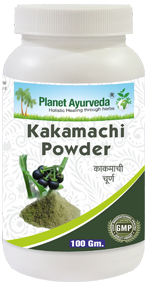What are the Uses and Health Benefits of Makoy (Solanum nigrum)?
The scientific name of Makoy is Solanum nigrum. The other name is Black Night Shade. It has characteristic features like it is the small, erect, soft and delicate herb of Ayurveda with smooth and soft branches and stems. Makoy has many medical benefits like- analgesic, reduces pain and inflammation, expectorant, sedative by nature, and diaphoretic properties. Makoy herb also manages the skin problems like burns, itching, and pain etc. if applied locally.
Description
Makoy is a common herb or short-lived shrub, found in many woody areas, as well as other habitats. It is of 12 to 47 inches, leaves are 1.6 to 3.0 inches long and 1 to 2 inches wide and is ovate or heart-shaped. The flowers are greenish or whitish petals, which are curved and surround with bright yellow anthers. These makoy berries are purple-black to dull black in color and 6-8 mm in size. In India, these berries turn red when they are ripe.
Synonyms:-
- Sanskrit name: Kakamachi, Kakahva
- English: Common nightshade, Garden Night Shade
- Hindi: Makoy
- Kannada: Ganikayeagida, Ganikegida, Ganike,
- Marathi: Kamoni
- Urdu: Makoh, Mako
- Tamil: Manarthakkali, Manaththakkali
- Telugu: Kamanchi
- Punjabi: Mako
Sanskrit Synonyms:-
- Bahuphala: Has many fruits
- Sarvattikta, Bahutikta: Fruit have a bitter taste
- Gucchaphala: Fruits found in clusters
- Kustagni: Treats skin disease
- Kakini, Vayasi, Kakamachi, and Kakahva: The fruits are liked by crows.
Important Characteristic:-
Makoy is considered as poisonous plant. The leaves of the plant have the property of cleansing which when consumed results in too much of sweating. It improves and promotes the perspiration which helps in maintaining and managing overall body temperature.
Habitat:-
It is a weed of 30-45 cm, found in dry parts of India, the cultivation of this herbal plant is commonly seen on roadsides and gardens. S. nigrum is also distributed in temperate Asia, Africa, Japan, and Europe.
Parts Used:-
The whole plant, fresh leaves, fruits.
Classification
- Latin name: Solanum nigrum
- Family: Solanaceae
- Kingdom: Plantae
- Order: Solanales
- Genus: Solanum
- Species: S. nigrum
Medicinal Properties
- Rasa (Taste) – Tikta (Bitter)
- Guna (Qualities) – Snigdha (Slimy), Laghu (Light)
- Veerya (Potency) – Anushna (not hot)
- Vipaka – Katu (undergoes pungent taste after digestion)
- Karma (Actions) – Tridoshagna (reduces all three doshas)
Chemical Composition
The herb is loaded with chemical compositions like- Steroidal alkaloid glycosides, solasonine, alpha, sapogenin, diosgenin, epicatechin, gallic acid, rutin,naringenin, and few more.
Medicinal Uses of Makoy
- Expectorant
- Analgesic
- Sedative
- Diaphoretic
- Skin diseases
- Anti-inflammatory
- Antiseptic
- Antibiotic
- Anti-allergic
- Anti-diabetic
- Cardio tonic
- Good herbal diuretic
Traditional Uses of Makoy
- Rasayani: Anti-aging, causes cells and tissues rejuvenation.
- Hrudya: Act as a cardiac tonic, congenial for the heart.
- Vrushya: Aphrodisiac, improves vigor.
- Sara: Induces mobility, causes diarrhea, purgation, relieves constipation.
- Svarya: Improves voice tone and quality.
- Netrahita: Good for eyes.
- Shukrada: Improves sperm quality.
Health Benefits of Makoy
- For painful joints poultice of leaves are prepared and applied locally.
- Roots of the plant are used for insomnia. The roots are boiled in water and a decoction is prepared and filtered and taken 10-20 ml.
- Ear drops are prepared from lukewarm juice of leaves to get relief from pain in ears.
- Stomatitis is known as inflammation in the mouth of the mucous membrane. Mukh-Pak is the name of the disease in Hindi. Chewing 5-6 fresh leaves of this herbal plant are helpful.
- In this condition, juice of the plant is given. Fresh juice is extracted and heated in the earthen vessel until its color changes. This is given in a dose of 25-50 ml for some days.
- In spleen enlargement, the decoction of the plant is prepared. In this decoction sendha namak is mixed with cumin seeds and this decoction is taken once.
- For skin disease, a paste of leaves are prepared and applied externally.
- The fresh leaves are cooked like we cook vegetable by adding onion and jeera. The fresh leaves juice is also taken for managing the stomach and ulcers.
- Consume berries for better respiratory health.
- Juice of this herb is used to treat fever and to alleviate pain.
- Juice also counter difficult menses.
- Fruit of Makoy is useful in cosmetic. Rubbing seeds on cheeks remove freckles.
- Various skin issues like acne, psoriasis, freckles can be treated with Makoy.
- Used as an enema in infants suffering from abdominal upsets.
- A Decoction of stalk, leaves, and roots of this herb is beneficial for wounds, and cancerous sores.
- In gum diseases.
- In eye diseases like conjunctivitis and itching sensation, the eye is fumigated with leaf applied with ghee and butter.
- Strengthen hair roots to improve the color of scalp hair.
- Treat urticarial patches, ginger is pounded with the juice of Makoy and given in a dose of 20 to 30ml.
- Antidote to opium poisoning and also treat rat bite.
Side-Effects
Makoy contains solanine and glycoalkaloid. The herb has is toxic depending on the dependent. All depends on the soil type, climate, season, and maturity. The green unripe berries are generally considered to be more toxic than the ripe berries. Few cases of poisoning after eating ripe berries of the plant are also noted. By cooking, boiling (decoction) the toxic components of the plant are destroyed as the plant is considered to be edible after cooking.
Contraindications
- Makoy due to its poisonous property is not given in any of pediatric age group.
- Its extra doses lead to death from cardiac arrhythmia, vomiting, diarrhea, convulsions or may be a paralytic attack.
- Leaves are strong purgative when consumed and stimulate a strong sweating response.




